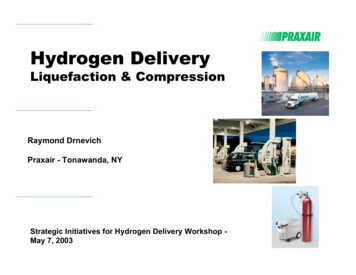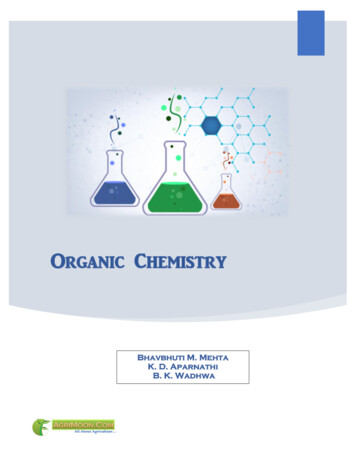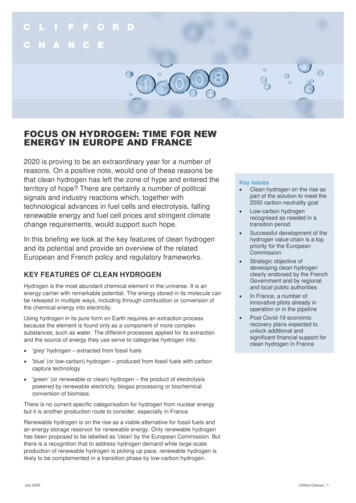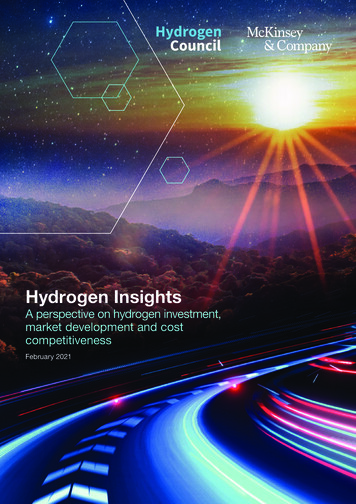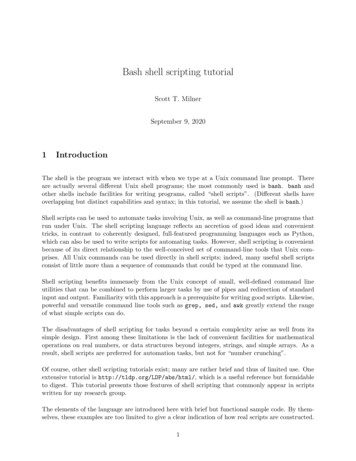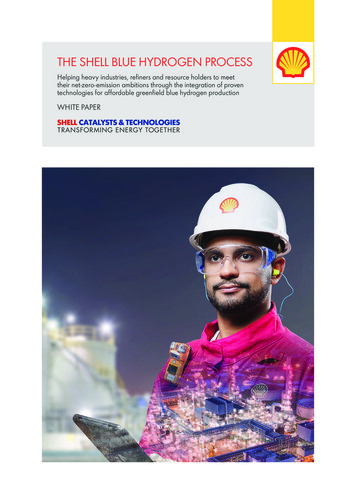
Transcription
THE SHELL BLUE HYDROGEN PROCESSHelping heavy industries, refiners and resource holders to meettheir net-zero-emission ambitions through the integration of proventechnologies for affordable greenfield blue hydrogen productionWHITE PAPER
CONTENTS1. Why blue hydrogen?42. Greenfield technology options63. The history of SGP technology114. CCUS experience125. Key takeaways136. About the author147. About Shell Catalysts & Technologies15To meet net-zero-emission ambitions, low-carbon hydrogen production mustincrease rapidly. “Blue” hydrogen production from natural gas along withcarbon capture, utilisation and storage (CCUS) is necessary to bridge thegap until large-scale hydrogen production using renewable energy becomeseconomic. The cost of carbon dioxide (CO2) already makes blue hydrogenvia steam methane reforming (SMR) competitive against grey (withoutCCUS), and the Shell Blue Hydrogen Process (SBHP) further increases theaffordability of blue hydrogen for greenfield projects.
Shell Catalysts & TechnologiesAre you .under pressure to decarbonise your existing operations? a resource holder looking for ways thrive through the energy transition and to create value from naturalgas by becoming a low-carbon energy producer?The SBHP improves the cost-effectiveness of greenfieldblue hydrogen production, thereby making it an attractiveinvestment option.3
Shell Catalysts & Technologies1. WHY BLUE HYDROGEN?A growing number of national governments and energy companies, including Shell [Ref 1], haveannounced net-zero-emission ambitions. Although renewable electricity is expanding rapidly, withoutlow-carbon hydrogen as a clean-burning, long-term-storable, energy-dense fuel, a net-zero goal is difficultto achieve, especially when it comes to decarbonising fertiliser production and hard-to-abate heavyindustries such as steel manufacturing and power generation. Hydrogen also has potential as a transportand heating fuel that could repurpose existing gas distribution infrastructure or be introduced into existingnatural gas supplies.Consequently, hydrogen plays an important part in many green strategies. The EU’s hydrogen strategy[Ref 2] published in July 2020 describes it as “essential to support the EU’s commitment to reach carbonneutrality by 2050 and for the global effort to implement the Paris Agreement while working towardszero pollution”.Momentum is building with a succession of commitments to hydrogen by various companies andgovernments. For example, in June 2020, Germany announced a 9-billion hydrogen strategy [Ref 3],and the International Energy Agency says that “now is the time to scale up technologies and bringdown costs to allow hydrogen to become widely used” [Ref 4]. Over the last three years, the numberof companies in the international Hydrogen Council, which predicts a tenfold increase in hydrogendemand by 2050 [Ref 5], has jumped from 13 to 81 and includes oil and gas companies, automobilemanufacturers, trading companies and banks.In 2018, global hydrogen production was 70 Mt/y [Ref 4]. Today’s demand is split between being usedfor upgrading refined hydrocarbon products and as a feedstock for ammonia production for nitrogenfertilisers. Nearly all production comes from fossil fuels: it accounts for 6% of natural gas and 2% of coalconsumption, and 830 Mt/y of CO2 emissions [Ref 6] – more than double the UK’s emissions [Ref 7].“Grey” hydrogen is a major source of CO2 emissions.If hydrogen is to contribute to carbon neutrality, it needs to be produced on a much largerscale and with far lower emission levels.Production cost, /kg hydrogen654321CO2 priceOperating expenditureFuel costCapital uehydrogenFigure 1: Hydrogen production costs in 2030.4
Shell Catalysts & TechnologiesLong term, the answer is likely to be “green” hydrogen, which is produced from the electrolysis of waterpowered by renewable energy. This supports the integration of renewable electricity generation bydecoupling production from use. Hydrogen becomes a convertible currency enabling electrical energyto be stored and for use as an emissions-free fuel and chemical feedstock.Green hydrogen projects are starting. For example, a Shell-led consortium is at the feasibility stageof the NortH2 wind-to-hydrogen project in the North Sea, and a Shell–Eneco consortium secured theright to build the 759-MW Hollandse Kust Noord project at a subsidy-free Dutch offshore wind auctionin July 2020; this project will include a green hydrogen technology demonstration.However, electrolysis alone will not meet the forecast demand. It is currently expensive and there isinsufficient renewable energy available to support large-scale green hydrogen production. To putthe scale of the task into perspective, meeting today’s hydrogen demand through electrolysis wouldrequire 3,600 TWh of electricity, more than the EU’s annual use [Ref 4]. Moreover, using the currentEU electricity mix would produce grey hydrogen from electrolysis with 2.2 times the greenhouse gasemissions of producing grey hydrogen from natural gas [Ref 8].An alternative is blue hydrogen produced from natural gas along with CCUS. Hydrogen productionvia electrolysis has a similar efficiency to blue hydrogen production, but the levellised cost ofproduction is significantly higher for electrolysis at 66/MWh compared with 47/MWh forSMR–CCUS [Ref 9].In addition, it is widely acknowledged that scaling up blue hydrogen production will be easier thandelivering green hydrogen. For example, the EU strategy [Ref 2] says that “other forms of lowcarbon hydrogen [i.e., blue] are needed, primarily to rapidly reduce emissions andsupport the parallel and future uptake of renewable [green] hydrogen”.The strategy goes on to say that neither green nor blue hydrogen production is cost-competitiveagainst grey: the hydrogen costs1 estimated for the EU being 1.5/kg for grey, 2.0/kg for blue andup to 5.5/kg for green [Ref 4].With the cost of CO2 at 25–35/t, blue hydrogen becomes competitive against grey, even with highercapital costs, and green hydrogen may still be more than double the price of blue hydrogenby 2030 [Ref 4]. Some forecasts indicate cost parity will occur in about 2045 [Ref 10].1Based on an assumed natural gas price for the EU of 22/MWh, an electricity price of 35–87/MWh and capacity costs of 600/kW5
Shell Catalysts & Technologies2. GREENFIELD TECHNOLOGY OPTIONSThis paper considers three technology options for greenfield blue hydrogen projects: SMR,autothermal reforming (ATR) and Shell gas partial oxidation (SGP) technology (Figure 2).BESTBETTERGOODSGP technologyATRSMRNoncatalyticDirect heatingCatalyticOxygen-based without steamCatalyticDirect heatingIndirect heatingOxygen-based with steamNon-oxygen-based with steamRefractory-lined reactor withcatalyst bedMultitubular with external firingProven for grey hydrogen, butthe alternatives may be bettersuited for blue hydrogenRefractory-lined reactorOffers key advantages overATR, for example, for a 500-t/dhydrogen production unit:As an oxygen-based system,more cost-effective than SMRfor blue hydrogen 30 million/y loweroperating expenditure;35% less power import;and10–25% lower levellisedcost of hydrogenSMRLarge reference base, butrequires post-combustion CO2capture for 90% captureATRFeed pretreatmentSteam for reactionFired heaterSGPNo or minimal feed pretreatmentSteam production using waste heatNo direct CO2 emissions from processSteamCH4Feed gaspretreatmentCO2Flue gasSMRCO shiftSteamCH4FeedheaterFeed gaspretreatmentFlue gas(CO2emissions)ATRAirPowerCH4 or refinery fuel H2PurificationH2CO2CO shiftCO2captureO2AirseparationHigh-pressure steamFigure 2. Blue hydrogen technologies and process line-ups.6CANSOLVCO2SGPO2AirseparationCO shiftCO2CO2capture
Shell Catalysts & TechnologiesSMRSMR, a proven catalytic technology widely applied for grey hydrogen production, usessteam in a multitubular reactor with external firing for indirect heating. Post-combustion carboncapture can be retrofitted to convert grey hydrogen production to blue. For example, theShell CANSOLV2 CO2 Capture System is proven to capture nearly all the CO2 (99%) from lowpressure, post-combustion flue gas.However, for greenfield blue hydrogen applications, oxygen-based systems such as ATR andSGP technology are more cost-effective than SMR (Figure 3), a conclusion backed by numerousstudies and reports [Ref 11]. Note that the cost of CO2 makes grey hydrogen via SMR moreexpensive than blue hydrogen from SGP technology. The cost advantage of oxygen-basedsystems over SMR increases with scale because the relative cost of the air separation unitdecreases with increasing capacity. Another advantage is that more than 99.9% of the CO2 canbe captured using the lower-cost, pre-combustion Shell ADIP ULTRA solvent technology.ATRLevellised cost of hydrogenATR uses oxygen and steam with direct firing in a refractory-lined reactor with a catalyst bed. Itis more cost-effective than SMR, but requires a substantial feed gas pretreatment investment andthe fired heater produces CO2 emissions (Figure 2).Grey hydrogen with SMRCapitalexpenditureBlue hydrogen with SMR and pre -combustion CCSOperatingexpenditureBlue hydrogen with SMR and pre -combustion CCSGas feedCO2Blue hydrogen with SGP andADIP ULTRA technologyCO2 intensityFigure 3: Relative CO2 intensity and cost of grey and blue hydrogen via SMR with pre- andpost-combustion capture, and blue hydrogen via SGP and ADIP ULTRA technology.² CANSOLV is a Shell trademark.7
Shell Catalysts & TechnologiesSGP TECHNOLOGYSGP technology is also an oxygen-based system with direct firing in a refractory-lined reactor, but itis a noncatalytic process that does not consume steam and has no direct CO2 emissions. Comparedwith SMR, SGP technology saves money by maximising carbon-capture efficiency and simplifying theprocess line-up, both of which offset the cost of oxygen production (Figure 4).A key advantage of SGP technology over ATR is that the partial oxidation reaction does not requiresteam as a reactant. Instead, high-pressure steam is generated by using waste heat from the reaction,which can satisfy the steam consumption within the SBHP as well as some internal power consumers.With no need for feed gas pretreatment, SGP technology has a far simpler process line-up than ATR(Figure 2) and, as a noncatalytic, direct-fired system, it is robust against feed contaminants such assulphur and can thereby accommodate a large range of natural gas quality, and thus give refinersgreater feed flexibility to decarbonise refinery fuel gas.Before investing in post-combustioncapture, the energy efficiency canbe increased by installing pre- andparallel reformers and byminimising direct CO2 emissionswith syngas firingIncreaseInstalling low-pressure,post-combustion carbon-capturetechnology on the flue gasstream and a CO2 compressoradds substantial costDecreaseTotalRelative total capital investment, %120710010039With SGP ADIP ULTRA technology,proven higher operating pressuresminimise the hydrogen and CO2compression duties—480Higher operating pressures ensure 95% CO2 capture with greatersolvent utilisation—276040131757—2536—154120Grey hydrogen can still beproduced with SGP but thetechnology adds more value forblue hydrogen applications0Greyhydrogenwith SMREnergyefficiencyincreasePostCO2SMR postcombustion compression combustioncapturecaptureReducedhydrogenand CO2compressorstateProcessInstallation SGP ADIPHighof airULTRApressure pre- simplificationseparation technologycombustionunitcapture stateRemoveCCScapabilityFigure 4: Relative capital investment comparison between grey and blue hydrogen viaSMR and SGP technology.8Pre-reformer, parallel reformer andsyngas firing are not required. Thesesimplifications and more efficientCO2 capture compensate for theprice of the air separation unitGreyhydrogenwith SGP
Shell Catalysts & TechnologiesSGP technology provides substantial savings compared with ATR: a 22% lower levellised cost ofhydrogen (Figure 5). This saving comes from a 17% lower capital expenditure owing to the potential fora higher operating pressure leading to smaller hydrogen compressor (single-stage compression), CO2capture and CO2 compressor units, and a 34% lower operating expenditure (excluding the natural gasfeedstock price) from reduced compression duties and more steam generation for internal power. SGPtechnology consumes 6% more natural gas, but this is offset by power generation from the excess steam.The SBHP is an end-to-end line-up that maximises the integration of SGP and ADIP ULTRA technologies.Compared with an ATR unit, modelling shows that a SBHP line-up producing 500 t/d of pure hydrogenwould have:3 30 million/y lower operating expenditure;35% less power import; 99% CO2 capture; anda 10–25% lower levellised cost of hydrogen.The SBHP is the best option for large-scale blue hydrogen projects. Figure 6 shows the principleadvantages of integrating the SBHP with other Shell and open-source technologies.ATRSGP120Relative cost, %1061008010010010010083786660Levellised cost ofhydrogen22% lower owing to a:17% lower capitalexpenditure; and34% lower operatingexpenditure (notincluding natural gasfeedstock price)Plant capitalexpenditurePotentially higheroperating pressureleading to a smaller:hydrogencompressor; andCCS plantPlant capitalexpenditureReducedcompression dutiesMore steam forinternal powergenerationNatural gas feedstock price6% greater natural gasconsumption but offsetby having more steamavailable for powergenerationMinimal feed gaspretreatmentFigure 5: The cost of SGP technology relative to ATR.Excluding inerts, methane, CO2 and carbon monoxide, which will also be present, depending on the final purification step: based on costs of 396/te for natural gas, 8.4/te for demineralised water and 86/MWh for power import; estimated costs for solvent, triethylene glycol andcatalyst; hydrogen discharge pressure of 72 bara and CO2 discharge pressure of 150 bara; and 95% plant availability39
Shell Catalysts & TechnologiesThe choice between a methanator or pressure-swing absorption unit for the hydrogen purification stepdepends on the required hydrogen purity. For example, a pressure-swing absorption unit is necessaryto achieve the 99.97% purity required for the hydrogen used in fuel cells. The off-gas is predominantlyhydrogen with trace containments such as carbon monoxide, CO2 and nitrogen. In the ATR process, thisoff-gas is typically burned to preheat the natural gas, which produces direct CO2 emissions.In a methanator, the purity of the final hydrogen is lower ( 98%, depending on the feed gas properties).However, it avoids direct the CO2 emissions from burning the pressure-swing absorption off-gas. Themain advantage of choosing a methanator is that hydrogen is not lost via the pressure-swing absorptionoff-gas. Consequently, it reduces natural gas consumption for the same hydrogen production. Inaddition, a methanator is commonly applied in industry, as it satisfies the hydrogen purity requirementsof most industrial consumers.Lower methane slip as SGPoperates at high reactor temperaturesBoiler feedwaterNaturalgasand/orrefineryfuel gasAirSGPreactorHotsyngasEnergy sufficiency. Producedsteam satisfies most internal usersSaturated steamSyngaseffluentcoolerCooledsyngasSuperheated steamWater ATED SBHPFeed flexibility. Noncatalyticprocess means robustness against feedcontaminants (sulphur, olefins, C2 )Shell proprietary technologyHigher operating pressure.Hydrogen compression duty andADIP ULTRA CO2 capture efficencyare improvedTo internal users (air separation unit, CO2removal unit, triethylene glycol dehydrationand power generation)ADIP ULTRACO2 tHydrogencompressionMedium-pressure CO2Low-pressureCO2CO2 compressionand dehydrationHigh-pressure CO2to storageIntermediate flash. High capture pressuremeans most of CO2 can be regenerated at amedium pressure to minimise CO2 compressor sizeShell technology embeddedOpen-source technologyFigure 6: The advantages of integrating the SBHP with other technologies, with Shell as the masterlicensor.10Hydrogenproductexport
Shell Catalysts & Technologies3. THE HISTORY OF SGP TECHNOLOGYSGP is a mature (TRL9), “low-carbon” technology eligible for government funding.Shell has a long history of developing SGP technology, beginning with research in the 1950s (Figure 7).Today, SGP has over 30 active residue and gas gasification licensees, and more than 100 SGP gasifiershave been built worldwide.For example, in the Pearl gas-to-liquids plant, Qatar, 18 SGP trains, each with an equivalent purehydrogen production capacity of 500 t/d have been operating since 2011.4 Since 1997, Pernis refinery,the Netherlands, has been operating at a 1-Mt/y CO2 capture capacity using SGP technology: the CO2is used in local greenhouses. The CO2 stream is an essential part of the Pernis CCS project (Figure 8).1956199619972006Amsterdam, NetherlandsLG Chemicals, Yochon andWesselingShell Pernis, NetherlandsEni, SannazzaroShell begins oil gasificationresearch and developmentBurner design development,co-annular designSyngas effluent cooler designCapacity: 550 t/dSuperheater designCapacity: 600 t/d61 YEARS OF EXPERIENCE IN MATURE PLANTS2009SGP capacity scaled to1,200 t/dBurner development.Capacity: 1,050 t/d200820112016Fujian refinery, ChinaNexen (OPTI), CanadaPearl gas-to-liquids plant,QatarJazan power project, SaudiArabiaSGP syngas generationcapacity doubledCapital expenditure reductionand optimisationFigure 7: SGP development.Defined as pure hydrogen production, i.e., not including any inerts, methane, CO2, or carbon monoxide, which will also bepresent, depending on the final purification step411
Shell Catalysts & Technologies4. CCUS EXPERIENCENo matter how cost-effective the hydrogen production and carbon capture technologies, withoutsequestering the CO2 directly or through enhanced oil recovery, the hydrogen remains grey.Shell has growing experience in CCUS through its long-term involvement in multiple CCUS projects indifferent phases of development (Figure 8), and can offer key insights into each of the four major stepsin CCUS:1. Capture – Shell Catalysts & Technologies has two proven carbon-capture technologies: ADIP ULTRAsolvent technology and the CANSOLV CO2 Capture System.2. Compression – The captured CO2 is compressed into liquid form for transport using commercial,fully available technology.3. Transport – The CO2 is moved from the industrial site where it is produced to its storage site, whichcould be on- or offshore. It is generally pumped through a pipeline, but ship transport may also play arole.4. Utilisation and storage – The CO2 is either injected deep underground into the microscopicspaces in porous rocks or it is sold for uses such as in the beverage industry or in greenhouses.Although the market size for those applications is small, this is highly relevant for those refiners locatednear other industries that need CO2.In addition, Shell has worked with customers on other crucial aspects, including location identificationand measuring, monitoring and verification to ensure that the CO2 is permanently stored.PROJECTS IN OPERATION186 25 473QuestTechnology CentreMongstadPROJECTS IN PLANNINGFigure 8: Shell CCUS experience.12Gorgon LNG CCSINVOLVEMENT THROUGHSHELL CANSOLV TECHNOLOGY– NO SHELL EQUITY
Shell Catalysts & Technologies5. KEY TAKEAWAYSHydrogen will be part of the future energy mix and there are several mature technologies availablefor producing cost-effective, low-carbon blue hydrogen.For greenfield applications, SMR is an inefficient method of producing blue hydrogen owing topoor CO2 recovery and scalability: oxygen-based systems offer better value (an independentlybacked conclusion).The SBHP, which integrates Shell SGP and ADIP ULTRA technologies, offers key advantages overATR, including a 10–25% lower levellised cost of hydrogen, a 20% lower capital expenditure, a35% lower operating expenditure (excluding natural gas feedstock price), 99% CO2 capturedand overall process simplicity.Shell has a long, proven record in blue hydrogen production with Shell SGP technology at the500-t/d scale and is a market leader in developing full-scale CCUS projects. The SBHP is nowavailable to third-party refiners.REFERENCES1. gy-business.html2. A hydrogen strategy for a climate-neutral Europe, European Commission (2020), www.ec.europa.eu/energy/sites/ener/files/hydrogen strategy.pdf3. ategie-kabinett-17589824. The future of hydrogen, International Energy Agency (2019), www.iea.org/reports/the-future-ofhydrogen5. Hydrogen scaling up. A sustainable pathway for the global energy transition, Hydrogen Council(2017), /hydrogen-scaling-up-hydrogencouncil.pdf6. www.iea.org/fuels-and-technologies/hydrogen7. www.edgar.jrc.ec.europa.eu/overview.php?v booklet2018&dst co2pc8. Shell hydrogen study: Energy of the future?, Shell Deutschland Oil GmbH (2017), ydrogen/ jcr content/par/keybenefits . Hydrogen from natural gas – The key to deep decarbonisation, Pöyry Management Consulting (2017),www.poyry.com/sites/default/files/zukunft erdgas key to deep decarbonisation 0.pdf10. Commercial scale feasibility of clean hydrogen, European Zero Emission Technology and InnovationPlatform (2017)11. Reference data and supporting literature reviews for SMR based hydrogen production withCCS, IEAGHG Technical Review 2017-TR3 (2017), ompvp/download13
Shell Catalysts & Technologies6. ABOUT THE AUTHORNan Liu, Licensing Technology Manager Gasification,Shell Catalysts & TechnologiesNan Liu has fulfilled roles throughout the project life cycle, from initial feasibilityand front-end development to project execution and plant operations, on majorcapital projects around the globe.These include the startup of the gasification unit at the Fujian refinery and ethyleneproject in China, and performance optimisation at the gasification and hydrogenplant at Shell’s Pernis refinery in the Netherlands. Nan has a strong commercialmindset and is a keen advocate of gasification as a value-adding investment.14
Shell Catalysts & Technologies7. ABOUT SHELL CATALYSTS & TECHNOLOGIESShell Catalysts & Technologies supports Shell and non-Shell businesses by working with them toco-create integrated, customised solutions comprising licensed technologies, refining and petrochemicalcatalysts, and technical services.It was formed by combining Shell Global Solutions, a technology licensor with a track record ofdelivering pioneering process schemes and innovative configurations; Criterion Catalysts & Technologies,the world’s largest hydroprocessing catalyst supplier; and CRI Catalyst Company, a pioneer in thepetrochemical catalyst sector.It operates across the energy value chain, from upstream, gas processing and liquefied natural gasthrough to downstream refining and petrochemicals.The fact that Shell Catalysts & Technologies supports Shell’s global downstream network means thatit has already addressed many of the challenges that its third-party customers face; the catalysts andtechnologies that it licenses have been developed in response to the same challenges.For further information, please visit our website at www.shell.com/ct.15
Shell Catalysts & Technologies is a network of independent technology companies in the Shell Group. In this material, the expressions “theShell Group” and “Shell Catalysts & Technologies” are sometimes used for convenience where reference is made to these companies ingeneral, or where no useful purpose is served by identifying a particular company.The information contained in this material is intended to be general in nature and must not be relied on as specific advice in connection withany decisions you may make. Shell Catalysts & Technologies is not liable for any action you may take as a result of you relying on such materialor for any loss or damage suffered by you as a result of you taking this action. Furthermore, these materials do not in any way constitute anoffer to provide specific services. Some services may not be available in certain countries or political subdivisions thereof.Copyright 2020 Shell Global Solutions International BV. All rights reserved. No part of this publication may be reproduced or transmittedin any form or by any means, electronic or mechanical including by photocopy, recording or information storage and retrieval system, withoutpermission in writing from Shell Global Solutions International BV.
SMR SMR, a proven catalytic technology widely applied for grey hydrogen production, uses steam in a multitubular reactor with external firing for indirect heating. Post-combustion carbon capture can be retrofitted to convert grey hydrogen production to blue. For example, the Shell CANSOLV2 CO 2 Capture System is proven to capture nearly all the .


